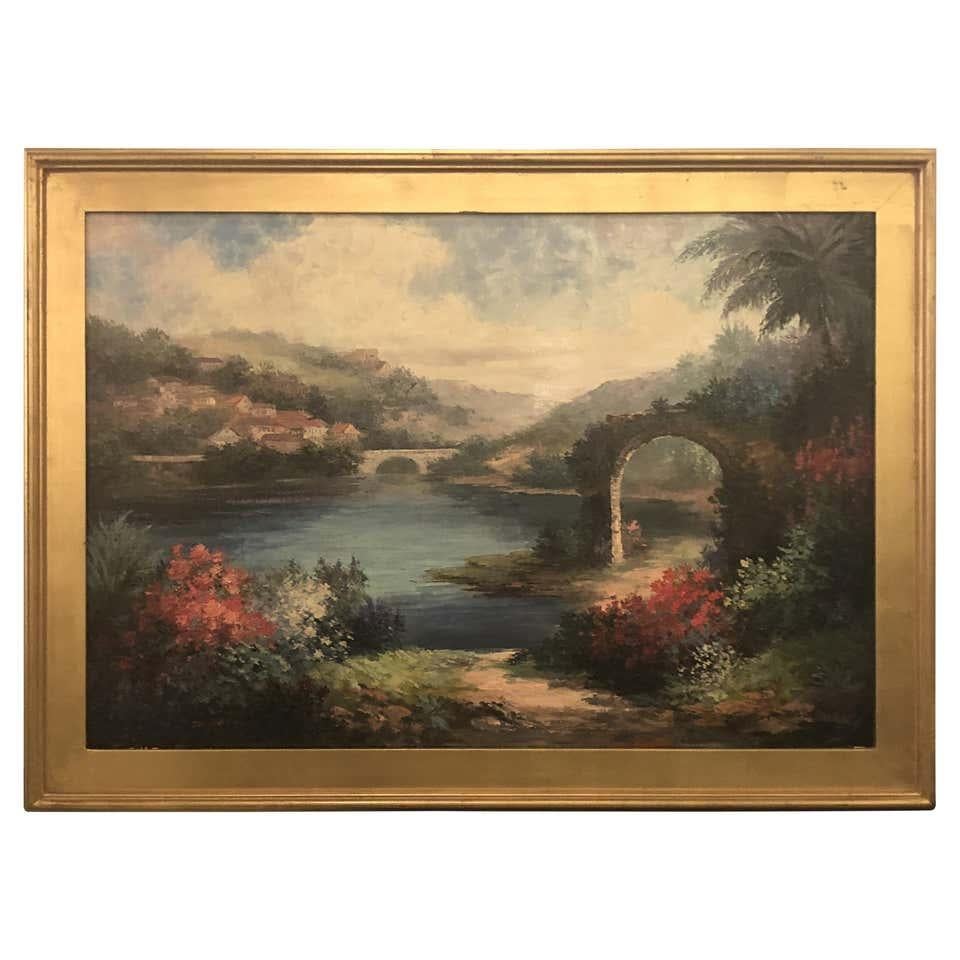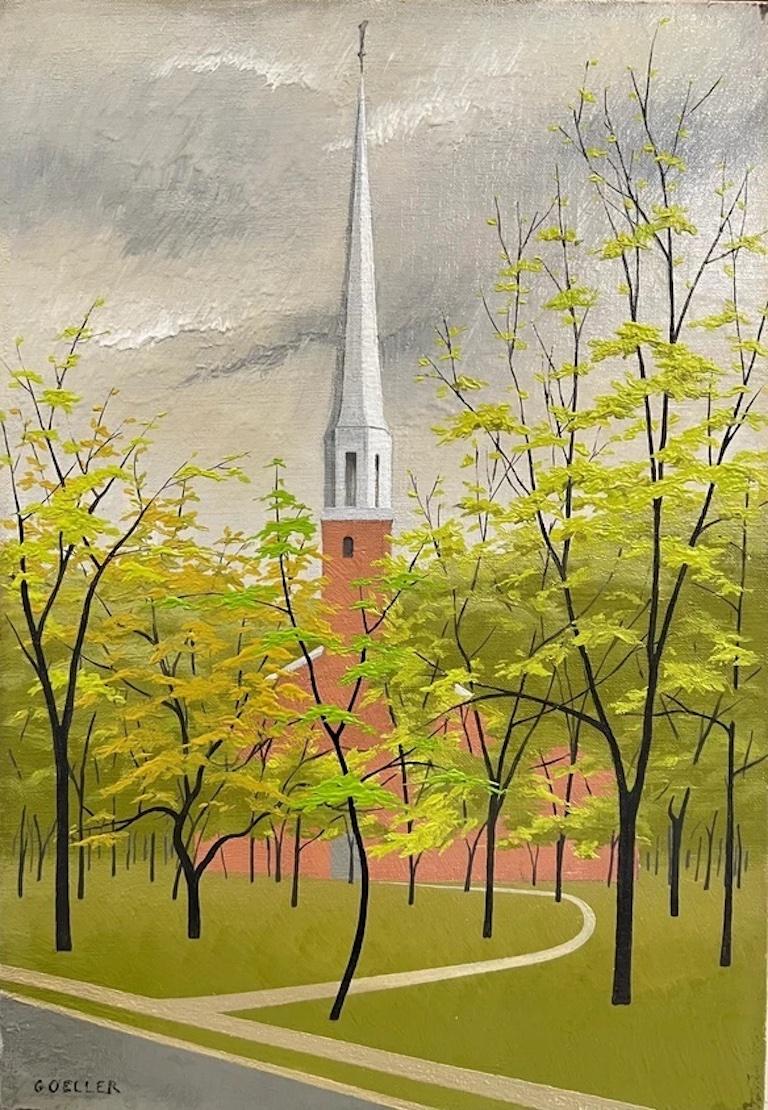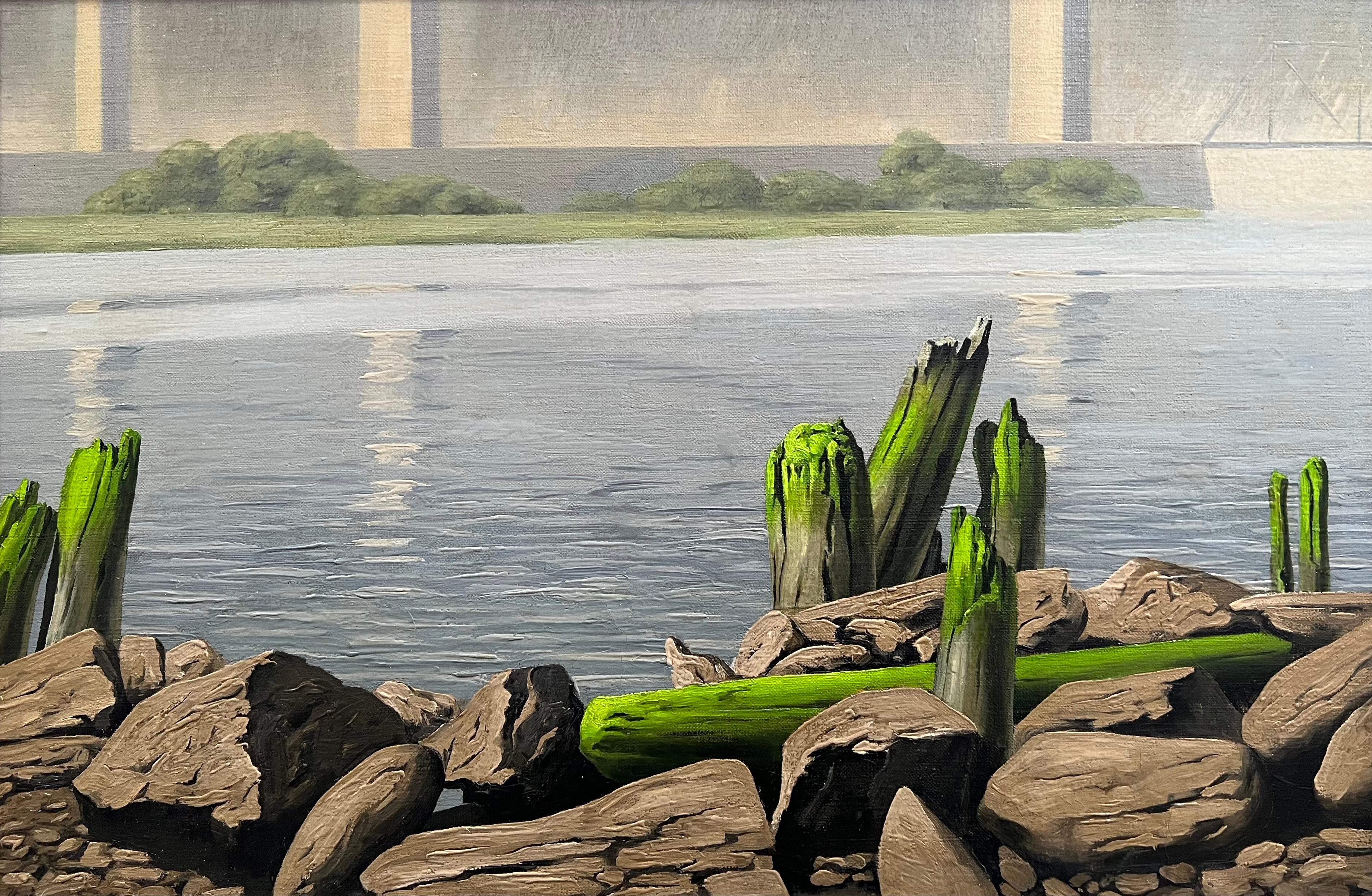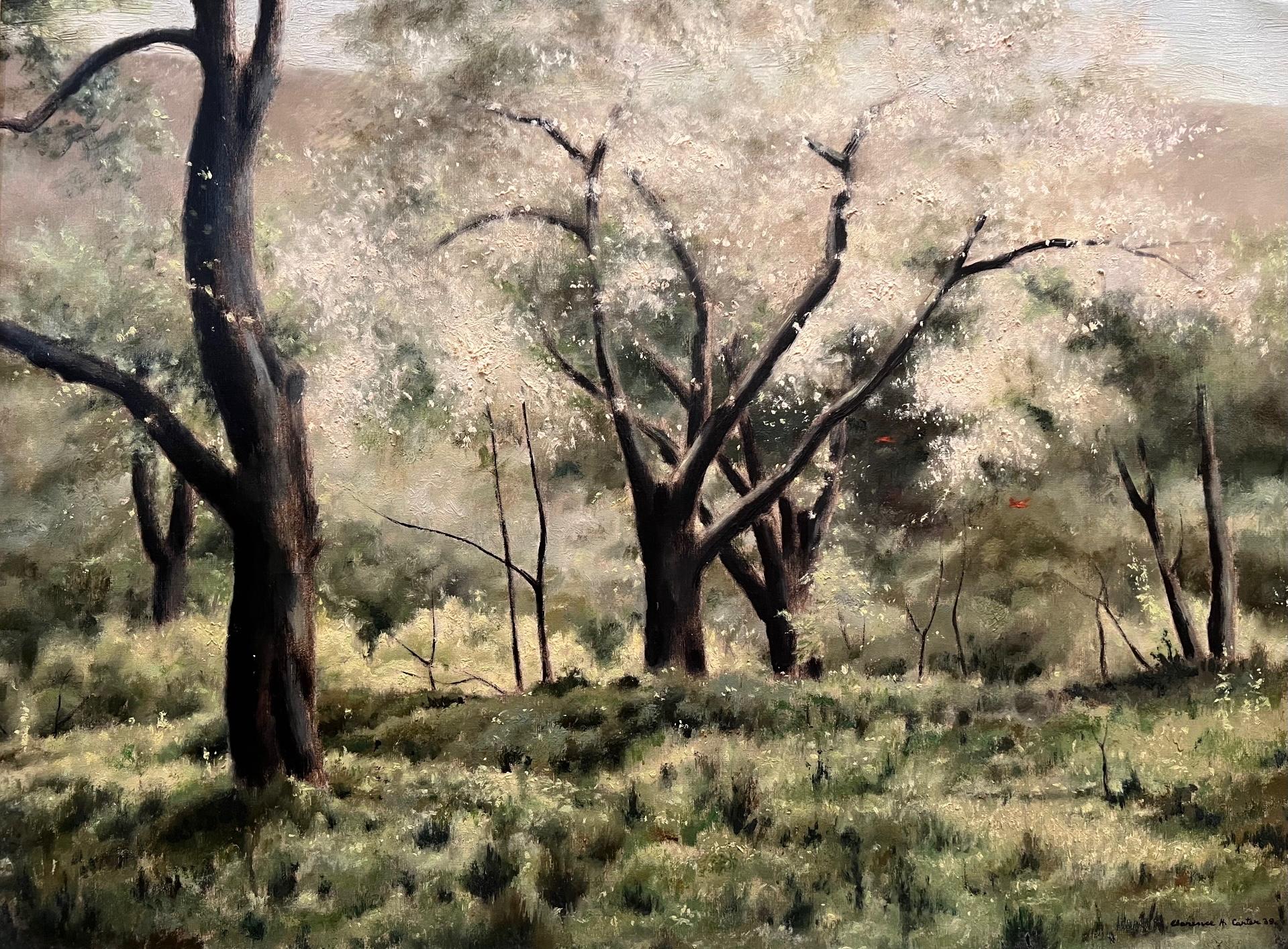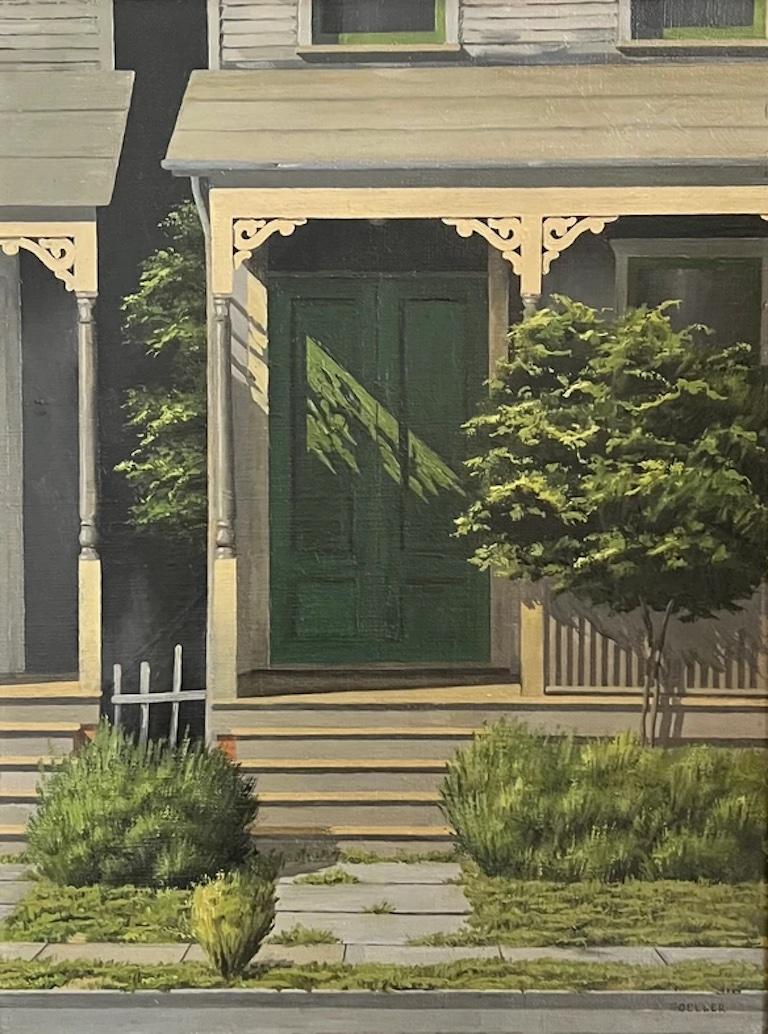Want more images or videos?
Request additional images or videos from the seller
1 of 6
Marcel Emile CaillietLandscape1940
1940
About the Item
Landscape, 1940, oil on canvas, 24 x 20 inches, signed, dated and titled verso: “Marcel Cailliet ’40 – S.C.” and “Marcel Cailliet Landscape”; likely exhibited at the annual juried students' exhibition of paintings at the Fine Arts Gallery of the United States Department of the Interior, Washington, DC., January/February, 1941, organized under the auspices of the United States Office of Education; Literature: Students’ Paintings Shown in Washington, The Los Angeles Times, February 11, 1941, Part I, p. 8 (“Of the 148 paintings selected, five were chosen from S.C.’s College of Architecture and Fine Arts . . . “Landscape” also was submitted by Marcel Cailliet, graduate student and now instructor at Arizona State Teachers College.”), presented in a newer frame
This work is part of our exhibition America Coast to Coast: Artists of the 1940s.
Landscape is a rare California Scene oil painting by the little-known, but talented, Marcel Cailliet. Cailliet painted Landscape in Los Angeles in 1940 during the last year of his MFA studies at the University of Southern California. Although still a student when he painted Landscape, Cailliet had already won awards and had his paintings included in prestigious museums and exhibitions, including the Golden Gate International Exhibition in San Francisco. Landscape itself was likely exhibited in Washington DC at the Fine Arts Gallery of the Department of the Interior in Washington DC, after having been selected in a national competition. The present work portrays a highly designed cluster of California ranch buildings and a windmill for drawing water from a well, all sitting above a sunken road where a rancher walks into the distance. These elements are typical of many regionalist paintings from the Depression Era Mid-West, but what sets Cailliet’s California landscape apart is its dramatic quality. By adopting a palette of strongly contrasting colors to render the stormy sky, the barns, the single figure, and the surrounding dry California hills, Cailliet creates dark, clearly defined and ominous shadows. The stark lighting, upward thrust of the ranch structures and the bare tree to the right of the composition are distinctly cinematic, which is not surprising given the influence movie and animation studio artists had over the Los Angeles artworld of the 1930s and 1940s. The overall feel of Landscape seems to recall the farm and tornado scenes from 1939’s The Wizard of Oz, as Dorothy’s fictional Kansas collides with the Southern California ranchlands.
Marcel Emile Cailliet lived and worked in Pennsylvania, California and Hawaii. There are conflicting records regarding his exact date and place of birth. He was born either in Dijon, France or Philadelphia, Pennsylvania. It is clear, however, that he was living in the United States from a young age. Cailliet graduated from Villanova University and studied at the Pennsylvania Academy of Fine Art before relocating to Los Angeles in 1938, where he and his family lived at 1302 W 45th St. Calliet’s Father was a professor of music at the University of Southern California and an arranger for Metro-Goldwyn-Mayer. Cailliet continued his art training in Los Angeles at the Chouinard Art School and in the graduate program at the University of Southern California’s School of Architecture and Fine Arts, where he received a Master of Fine Arts degree in 1940 and served as a painting instructor. While a student, he was a member of the Laguna Beach Art Association which awarded a prize to one of Cailliet’s marine paintings in 1939, the same year his works were exhibited at the Golden Gate International Exhibition and the Oakland Art Gallery. Cailliet was also a member of the California Watercolor Association. After graduating from USC, Cailliet became an assistant professor of painting at the Arizona State Teachers College in Tempe (now Arizona State) in late 1940. He was honored with a well-reviewed one-person show at the Lyceum Building soon after his arrival at Arizona State. In addition to painting, Cailliet designed theater sets and even puppets during his time in Tempe. In 1941, he married Helene Amoy, who was from a prominent family in Hawaii, and painter and muralist in her own right. In 1942, Cailliet stepped back from working full-time as a professional artist and painting instructor to accept positions in the aviation industry, first as a designing engineer for Goodyear Aircraft Corporation and later for Lockheed. He then served in the US Navy during World War II, including as the Executive Officer of the Navy Pacific University at Pearl Harbor, and he continued in the Naval Reserves into the 1950s. After leaving active service, Cailliet stayed in Hawaii where he pursued various business management roles, while working part-time as an artist. In 1946, he illustrated a book on Hawaiian Luaus and in the late 1940s and early 1950s, Cailliet taught painting at the Honolulu School of Art. Both Cailliets continued to paint and sometimes teach and exhibit their work through Helene’s death in 1986. Marcel remarried and lived a long life before his death in 2007.
- Creator:Marcel Emile Cailliet (1914 - 2007, French)
- Creation Year:1940
- Dimensions:Height: 20 in (50.8 cm)Width: 24 in (60.96 cm)Depth: 1 in (2.54 cm)
- More Editions & Sizes:20 x 24 inchesPrice: $5,500
- Medium:
- Movement & Style:
- Period:
- Condition:
- Gallery Location:Los Angeles, CA
- Reference Number:1stDibs: LU1859214251132
About the Seller
No Reviews Yet
Vetted Seller
These experienced sellers undergo a comprehensive evaluation by our team of in-house experts.
1stDibs seller since 2022
6 sales on 1stDibs
Typical response time: 8 hours
- ShippingRetrieving quote...Ships From: Los Angeles, CA
- Return PolicyA return for this item may be initiated within 3 days of delivery.
More From This SellerView All
- Amish Farmscape #3By Edmund LewandowskiLocated in Los Angeles, CAAmish Farmscape #3, 1984, oil on canvas, 40 x 30 inches, signed and dated lower right; signed, dated, and titled verso About the Painting Amish Farmscape #3 is part of a multi-painting series of barns completed in the early 1980s for an exhibition at New York’s prestigious Sid Deutsch Gallery. Lewandowski painted this work at an important point in his career. It was the first major project undertaken by Lewandowski after his retirement from serving as the Chairman of Winthrop University’s Art Department, the last academic position he held after teaching for nearly thirty years. Lewandowski had been inspired to work on the series by a visit to Lancaster County, Pennsylvania. Like his friend and mentor, Charles Sheeler, Lewandowski had always been fascinated by vernacular architecture and the Amish barns of Pennsylvania brought back memories of rural scenes Lewandowski had painted in the Midwest much earlier in his career. Amish Farmscape #3 is a strong example of Lewandowski’s late precisionist work. The complexity of the composition and Lewandowski’s technical acumen are on full display. Being relieved of the burdens of teaching and administering a university art department likely allowed Lewandowski greater freedom and most importantly more time to complete the Amish Farmscape series. Although Lewandowski’s brand of precisionism changed throughout the years, he never deviated from the core tenets of the Immaculate School artists. In this work, we see simplified and flattened forms, the use of ray-lines to define light and space, the elimination of extraneous details, a polished almost machine-like finish, and the complete lack of visible brushstrokes, all hallmarks of the precisionist painters. Lewandowski was the last of the 20th century precisionists and in Amish Farmscape #3, we see just how successfully he continued to work in this style until his death in 1998. About the Artist Edmund Lewandowski was among the best of the second-generation precisionist painters. He was born and raised in Milwaukee, Wisconsin and studied at the Layton School of Art with Garrett Sinclair. Lewandowski achieved early success when in 1936 two of his watercolors were shown at the Phillips Collection as part of a Federal Art Project exhibition. Then, in 1937, his work was first exhibited at Edith Halpert’s Downtown Gallery which represented Lewandowski into the 1950s. Under Halpert’s guidance, Lewandowski continued to explore watercolor as his main medium during the 1930s and 1940s, since the gallery already represented Charles Sheeler, who worked primarily in oils. Sheeler became Lewandowski’s major influence as the primary leader of the ill-defined, but very recognizable Immaculate School artists, which included other Downtown Gallery painters, Niles Spencer, George Ault, and Ralston Crawford, as well as Charles Demuth and Preston Dickinson, both of whom died at a young age and had been represented by the Charles Daniel Gallery. Sheeler is credited with giving Lewandowski technical advice on how to make his paintings more precise and tightly rendered and by all accounts, Sheeler was a fan of Lewandowski’s work. Through the Downtown Gallery, Lewandowski’s paintings were accepted into major national and international exhibitions and purchased by significant museums and collectors. Franklin and Eleanor Roosevelt and Nelson Rockefeller acquired works by Lewandowski. He was included in the Museum of Modern Art’s important 1943 exhibition, American Realists and Magic Realists as well as juried exhibitions at the Whitney Museum of American Art, the Pennsylvania Academy of Fine Arts, and the Art Institute of Chicago. Lewandowski also completed commissions for magazines during the 1940s and 1950s, including several covers for Fortune. Throughout his career, Lewandowski explored urban and rural architecture, industry, machinery, and nautical themes. Looking back on his career, Lewandowski wrote, “My overwhelming desire as an artist through the years has been to record the beauty of man-made objects and energy of American industry on canvas. For as far back as I can recall, the cityscapes, farms and depictions of industrial power and technological efficiency has had a great attraction for me. I try to treat these observations with personal honesty and distill these impressions to a visual order.” Lewandowski is credited with extending precisionism to the Midwest and successfully continuing the style into the 1990s, three decades after Sheeler’s death and six decades after Demuth’s passing. Late in his career, Lewandowski enjoyed a resurgence of popularity as he was represented during the 1980s by New York’s Sid Deutsch and Allison Galleries...Category
Mid-20th Century American Modern Landscape Paintings
MaterialsCanvas, Oil
- Untitled (Collapsed Shacks)By Karl FortressLocated in Los Angeles, CAUntitled (Collapsed Shacks), c. 1940s, oil on canvas, signed lower left, 20 ½ x 26 ½ inches, presented in a period frame This work is part of our exhibition America Coast to Coast: ...Category
1940s American Modern Paintings
MaterialsOil, Canvas
- Untitled (Farm in Winter)By Julius M. DelbosLocated in Los Angeles, CAThis work is part of our exhibition America Coast to Coast: Artists of the 1940s Untitled (Farm in Winter), 1940s, oil on canvas, signed lower right, 26 x 30 inches, presented in a...Category
1940s American Modern Paintings
MaterialsCanvas, Oil
- Gracie MansionBy Isabella Banks MarkellLocated in Los Angeles, CAThis painting is part of our exhibition America Coast to Coast: Artists of the 1940s. Gracie Mansion, c. 1944, oil on canvas, signed lower right, 25 x 30 inches, presented in a ne...Category
1940s American Modern Paintings
MaterialsCanvas, Oil
- Gold Mine, Central City, ColoradoBy Joseph MeertLocated in Los Angeles, CAThis painting is part of our exhibition America Coast to Coast: Artists of the 1930s Goldmine, Central City, Colorado, oil on canvas, 36 x 28 inches, c. 1936, signed lower right, ex collection of Platt Fine Art, Chicago, Illinois (label verso). About the Painting Joseph Meert’s painting, Goldmine, Central City, Colorado, depicts the short-lived resurrection of a once prominent city just outside Denver. Central City was founded in 1859 soon after John Gregory struck gold in the area. As word spread, thousands of miners converged into “Gregory’s Gulch” and its surroundings became known as the “richest square mile on earth.” Mining production quickly increased resulting in Central City to becoming Colorado’s largest city in the early 1860s. Despite some technical difficulties transitioning to lode mining and the rise of competition from Leadville, Central City remained an economic boom town through the turn of the century. But, with every boom, there is a bust. World War I marked the end of Central City’s prominence as ore production ground to a halt and by 1925, the town’s population shrank to only 400 people. The desperation of the Great Depression and a nearly 100% increase in the price of gold lured labor and capital back to Central City. Meert painted in Colorado during the mid-1930s, a time when he created his most desirable works. It is during this period of renaissance that Meert captures one of Central City's outlying dirt streets bordered by 19th century wooden houses from the town's heyday and the more recently installed electric lines leading to a distant gold mine. A lone figure trudges up the hill, a mother with a baby in her arms, putting us in mind of the rebirth of the town itself. Meert had solo exhibitions at the Colorado Springs Fine Arts Center in 1936 and the Denver Art Museum. Although it is not known whether Goldmine, Central City was included in either of these exhibitions, it seems likely. Moreover, the painting is closely related to Meert’s painting, The Old Road, which was painted in 1936 and exhibited at the Corcoran Gallery of Art in Washington, DC and at the Dallas Museum of Art. About the Artist Joseph Meert was a well-regarded painter and muralist, who initially made a name for himself in the American Scene and later as an abstract expressionist. Although initially successful, Meert struggled financially and with mental illness later in life. He was born in Brussels, Belgium, but moved with his family to Kansas City, Missouri. As a child, a chance encounter at the Union Pacific Railyard changed his life. Meert happened upon a worker repainting and stenciling a design on a railroad car. Meert later recalled that this experience introduced him to the idea of being a painter. Without support from his father, Meert obtained a working scholarship to the Kansas City Art Institute. After four years at the Kansas City Art Institute, Meert studied seven years at the Art Students League and in Europe and Los Angeles. At the Art Students League, Meert fell under the spell of Thomas Hart Benton and Stanton MacDonald-Wright. In 1931, he befriended Jackson Pollock. By 1934, Meert was part of the Public Works of Art Project when he met his wife, Margaret Mullin...Category
1930s American Modern Landscape Paintings
MaterialsCanvas, Oil
- Arthur KillLocated in Los Angeles, CAThis painting is part of our exhibition Charles Goeller: A Wistful Loneliness. Oil on canvas, 15 ¾ x 24 inches, Signed and titled verso on stretcher Exhibited: [Solo Exhibition] Cha...Category
1940s American Modern Landscape Paintings
MaterialsCanvas, Oil
You May Also Like
- Americana Landscape Oil on Canvas Painting Signed P. Paul, FramedLocated in Plainview, NYAn elegant oil on canvas landscape painting featuring a lake view in a paradisiac environment. The painting is finely framed in custom giltwood frame. A wonderful addition to any liv...Category
1980s American Modern Landscape Paintings
MaterialsOil, Canvas
- Southern California Foothills oil by Anni BaldaughLocated in Hudson, NYCanvas measures 24" x 30" and framed 30" x 36" x 3" About this artist: Anni Baldaugh was the daughter of Anthonius Hendricus Schade van Westrum. With a father who was a naval officer, the van Westrum family spent significant amounts of time in the Dutch East Indies. After returning to Europe, Baldaugh studied art with various teachers in Vienna, Munich and Paris. She and her husband ended up living in Los Angeles, though they suffered financial losses during World War I. While in Los Angeles, Baldaugh joined the California Watercolor Club, the California Society of Miniature Painters, the Bookplate Association International, the Laguna Beach Art Association, and the San Diego Fine Arts Society. She also became a member of the Connecticut Academy of Fine Arts. During the Great Depression...Category
1930s American Modern Landscape Paintings
MaterialsOil, Canvas
- Fish Story oil painting by Williams Charles PalmerLocated in Hudson, NYThis painting is illustrated in the Catalogue of the 1945 Encyclopedia Britannica Collection of Contemporary American Painting, p.84. Written and edited by Grace Pagano. "Painting ...Category
Mid-20th Century American Modern Figurative Paintings
MaterialsOil, Canvas
- December 25thLocated in New York, NYIn his artwork entitled, “December 25th,” Alec Montroy paints a New York City street blanked with snow but illuminated still by the numerous neon signs ab...Category
Late 20th Century American Modern Landscape Paintings
MaterialsOil, Canvas
- StarsBy Dale NicholsLocated in New York, NYSigned and dated lower right: DALE NICHOLS 1953; on stretcher bar: “STARS” by Dale NicholsCategory
Mid-20th Century American Modern Landscape Paintings
MaterialsCanvas, Oil
- The Big News is Always on 42nd StreetLocated in New York, NYAlec Montroy depicts a group of figures standing on a street corner a few blocks from Times Square in his work entitled “ The Big News is Always on 42nd S...Category
Late 20th Century American Modern Landscape Paintings
MaterialsOil, Canvas
Recently Viewed
View AllMore Ways To Browse
Gary Zack Vase
George Kozmon
Vintage Original Expressionist Art
Bill Howard
Namibia Canvas
Dune Grasses
Valentino Acrylic
Scott Wilson
Never Against Virginia
Bluebell Wood
Irish Princess
Mary Sims Artist
1940s Opera Glasses
Mexican Baroque Painting
Color Block Early 1900s
Victoria Harbor
Barneys Display
Guy Benard Painting
